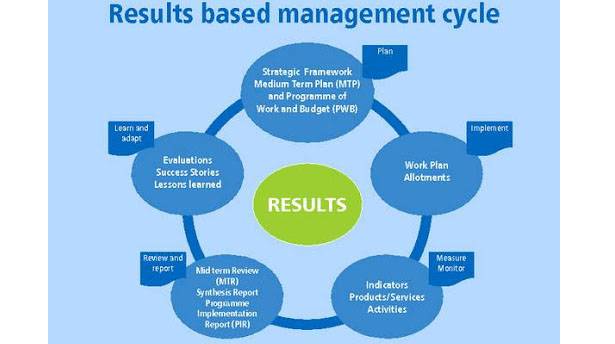Leveraging RBM for effective problem-solving, development

Rudo Grace Gwata-Charamba Correspondent
Development projects are aimed at solving problems and that entails addressing matters regarded as unwelcome or improving unsatisfactory situations.
This makes problem-solving an essential skill for promoting the success of initiatives and socio-economic development.
Every project has a particular focal problem which is also reason for needing a change in the current situation.
The project team thus ought to have the necessary capacity to realistically handle the problem; allowing the project to take advantage of local capacities and existing opportunities within its environment.
From both literature and experiential evidence, the Results Based Management (RBM) approach has proved to be a powerful tool for improving the implementation of projects and guaranteeing their success in both the public and private sectors.
This is because using the RBM approach ordinarily warrants the effectiveness of problem solving efforts.
In fact, individuals with sharp problem solving skills typically talk about solutions and measurable results more than just the tools and frameworks that they use.
Besides, they ensure that all their actions closely fit into the big picture with the business processes being means to a greater end. Both elements of behaviour denote basic characteristics of RBM.
RBM is a participatory and team-based approach to programme management that focuses on achieving defined and measurable changes in people’s lives (results).
The approach demands that stakeholders continually reflect on the extent to which the execution of project processes will lead to the achievement of desired change in behaviour within the target population.
Such change is among the most credible pieces of evidence relating to obtaining a solution to the problem being addressed.
For example, if the implementation of a project aimed at addressing poverty leads to the engagement of a community in income generating initiatives, then such change in behaviour clearly points to progress towards solving the problem.
By focusing on the target change, RBM helps to shift the focus of programming, managing and decision-making from inputs and intermediate processes to a consistent direct focus on the solution to a problem namely the actual socio-economic benefits of projects, at the level of beneficiaries.
Such focus also helps to strengthen management effectiveness, efficiency plus accountability and also improves project delivery as it prevents or minimizes resource allocation to non-essential processes.
Problem solving comprises three phases namely problem identification, proposing solutions and selecting the best strategy, implementing the solution and finally evaluating the process.
Problem solving cycle
The process of problem solving begins with the identification of the main problem which entails establishing whether or not a problem really exists, if it does then determine its nature, origin as well as all the collection more information about before plainly defining it.
Similarly, the RBM cycle begins with an assessment aimed at understanding the prevailing, identifying the problem, its source plus consequences as well as determining whether or not an intervention is required.
The need for an intervention is verified because the implementation of projects using the RBM approach are primarily determined by the potential of the intervention to make a difference or at least contribute to making such difference in the lives of the target population.
With its highly participatory characteristic, RBM adds on stakeholder analysis which involves assessment of the needs of all key stakeholder groups along with the preliminary institutional capacity available to solve the problem.
In addition, the problem is further analysed to establish its detailed profile including the associated cause-effect relationships.
The process enriches the process as more information, from different perspectives, is gathered and buy-in promoted through maximum participation.
Additionally, identifying the cause can ease the process of removing the same. RBM therefore boosts the problem identification process as well as the potential of the project to produce a smart, workable solution.
The next phase of problem solving, regarded as one of the most important stages, entails proposing possible solutions mostly from people with relevant experience in solving similar problems.
A range of possible courses of action is generated and listed along with the risk and benefits associated with each one of them and are availed for comparison.
Limiting the participation to experienced personnel in this process of has the disadvantage of equally limiting the variety of possible solutions.
Also, according to literature, a rigorous analysis of operational strategies considers different ways to solve a given situation while focusing on the intended effects rather than the existing knowledge and experience.
By underscoring the need to seek input from all key stakeholders as well as learning the RBM approach can effectively address this shortcoming
Selecting the best strategy from the list of proposals is ordinarily regarded as the most complex part of the process where entities often get stuck.
It demands careful analysis and evaluation of the different possible courses of action followed by sound decision-making.
The RBM cycle
The RBM cycle comprising the stages Assessment, Planning, Implementation as well as Review with Monitoring and Reporting as a continuous process, is closely aligned of problem solving cycle.
The planning phase encompasses identification of the problem, operational strategy as well as the formulation of the intervention logic.
Both the generation of alternatives and selection of a strategy are conducted during the planning and design phase of a project.
This phase begins with the definition of the desired future situation for the affected population to be brought about by the ensuing solution.
The objectives, strategies and activities needed to achieve the necessary change are identified, again taking into account available capacities, the organisational mandate as well as the constraints and risks involved.
The RBM processes thus allow for clarification of how the intervention will solve the problem, how such a solution fits into overall organisation setting.
Furthermore, the approach facilitates sharpening of focus, on the desired change, improved alignment of the required project processes with resource requirements as well as effective management of risks and assumptions.
These elements foster efficiency, effectiveness, relevance and sound management of the project, in general
Implementation is the critical peak of the problem-solving process where the course of action is accepted and the associated plan is formulated, shared and executed.
Monitoring is the final stage of this process and entails evaluating the effectiveness of the whole process through feedback from stakeholders, notably the beneficiaries.
Such practice of confining the monitoring task to the last phase undermines the effectiveness of the initiative as it negates timely correction plus continuous learning and adjustment.
Again the monitoring is confined to assessing success only whereas lessons learned from negative experiences often prove invaluable for the success of projects.
In the context of RBM, monitoring and reporting on progress of the project, towards the achievement of results as well as operational efficiency is a continuous process that takes place throughout the life of the project.
The related progress reports inform decisions on future planning or the adjustment of on-going project processes.
Learning and improvement are thus sponsored throughout the process again significantly enhancing the potential for the success of the project.
By measuring and managing for results, stakeholders access more information on what works and what does not which they use to guide sound decisions that promote improved project performance.
In addition, such use of information on both best practices and lessons learned facilitates timely correction and adjustment of processes which, in turn, promotes the effective delivery of development results.
Furthermore, the pronounced similarity between the RBM and problem solving processes make RBM a potentially viable means for strengthening processes of the later, with minimal but meaningful adjustment, and subsequently strengthening the performance of the associated development initiatives.
Dr Rudo Grace Gwata-Charamba is an Author, development Project/ Programme Management Consultant and Researcher with a special interest in Results Based Management (RBM), Governance and Leadership. She can be contacted via email: [email protected]









Comments